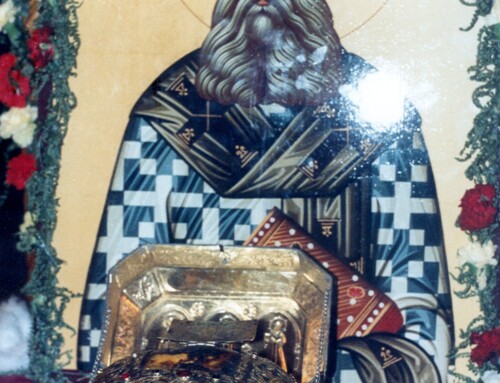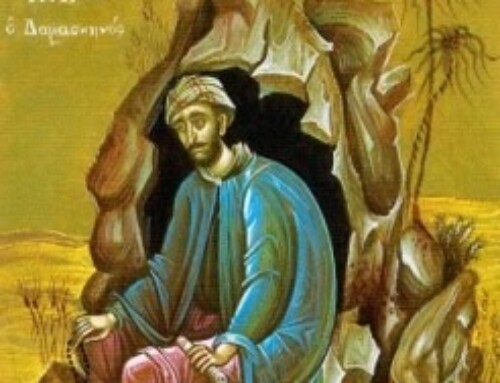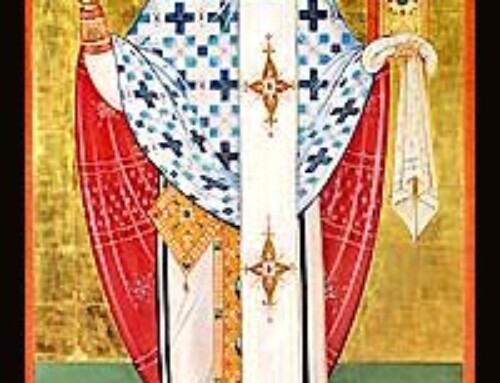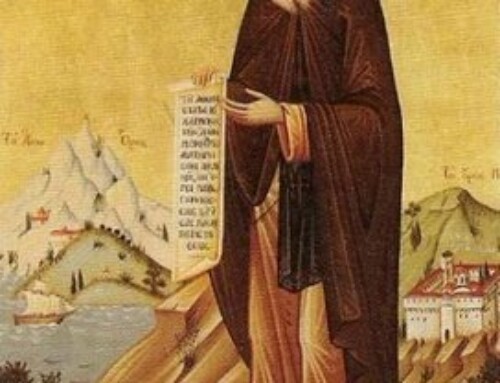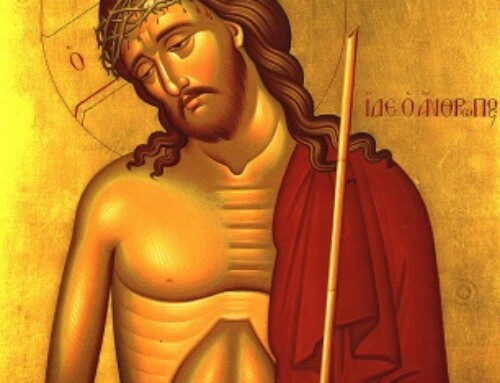Word Magazine October 1989 Page 4 – 7
“BEAR WITNESS TO THE LIGHT;
BRINGING ORTHODOXY TO AMERICA”
by Dr. Daniel Sahas
In the theme of your Convention, “Bear Witness to the Light; Bringing Orthodoxy to America,” you have combined, in an enlightening and delightful way, the Biblical injunction with the American quest:
There was a man sent from God, whose name was John. He came for testimony, to bear witness to the light, that all might believe through him. He was not the light, but came to bear witness to the light. (John 1:6-8)
Metropolitan Philip, Your Eminences, Your Graces, Reverend Fathers, Your Excellency, Beloved sisters and brothers in Christ, dearest Orthodox in North America:
A true man and a Christian, in the generic and essential sense of the words, is a being who is constantly “sent from God”. You, Antiochian Christians, have put flesh on this Christian understanding of the human nature. You reverted the name “Christian”, employed originally as a derogatory appellation for the unlettered and the underprivileged, and used in jest for “the follower of some charlatan who claimed to be the Messiah”, to a way of life and a role model. “Christian”, then, came to mean the Christ-like person, the imitator of Christ, the living and vibrant member of the mystical body of the incarnate Logos, the Light par excellence! And your third bishop, Ignatius of Antioch, incarnated and sealed this definition with his baptism of blood, in Rome, 1885 years ago!
“Light” is not a figurative expression; as Christ is not an abstraction, either. Ignatius did not witness to, nor did he become an imitator of an abstraction. Light is the definite state of existence that dispels darkness; the quality that makes things manifest. Light is the Way and power which transforms or, actually, transfigures the world. No surprise, therefore, that Christianity was originally called, even by its fiercest opponents, “the Way” (Acts 9:1-2; 19:9, 23; 24:14, 22). Paul makes a distinction between life as a set of “laws of our fathers” and “the Way” (Acts 24:14) as a living experience, which he persecuted in the person of concrete men and women, and to which “Way” he, himself, was converted! Pliny the Younger, in the beginning of the second century, reporting to the Roman Emperor about Christianity, described a particular mentality and behaviour, a certain kind of witnessing and conduct; a characteristic way of life by the Christians! And, centuries later, the envoys of Prince Vladimir, looking for a Faith, reported a particular conduct and way of liturgical life, which triggered the conversion of the Rus to Byzantine Orthodoxy.
What are, then, some of the ingredients and characteristic “ways” of the light which Orthodox are called to inculcate and bear witness to them in America? Allow me to mention, briefly, four of them.
1. Light as a way of convention and communion
Light brings people together. One puts the light on a stand “that those who enter may see the light” (Lk. 8:16). Light enables people to see and face each other as persons. This is, precisely, the meaning of the Greek word prosopon: the ability to face, and the quality to treat each other, not as numbers, units, bodies, denominations or masses, but as persons, with personal, unalienable and unrepeated characteristics; men, women and children for each one of whom Christ has died!
Thus, for example, conventions such as this, are opportunities to “enter”, to come together, to see each other under the same Light, and face each other as persons. Convention and light are interwoven categories. What the primitive man discovered was that one stone alone can produce neither light nor fire. Two of them, striking each other, can. That is why where two or three are gathered in His name, there is Christ in the midst of them (Cf. Mat. 18:20). Individualism (and this is not a numerical, but a mental category), dogmatism, absolutism, authoritarianism, egocentricism, spiritual or cultural imperialism, are characteristics alien to Orthodoxy; and these must be seen and treated as idiosyncracies, inclinations, preferences, that is, heresies! Coming together, being in communion with each other, challenging, talking, facing issues with each other and acting together, is an experience which is at the heart of our Christian Faith. Being in communion with each other (as members of an Orthodox community and as a family of Orthodox communities), is not a matter of choice in Christianity; it is a fundamental of faith. Our belief in a personal God speaks, precisely, of this notion of a communion of distinct persons in the Holy Trinity, in an eternal movement of love, according to Maximus the Confessor. The fact is not coincidental that in our Orthodox tradition, authority and truth are not manifested through any single person, or even through a concilium of ecclesiastical dignitaries
talking to each other; but rather through God-the-Holy Spirit in synod, in action, with the Church (men, women, children, clergy and laity) walking together towards their Emmaus. This is the extraordinary synodical ethos by which the Church has been constituted, fed and characterized, and to which we in North America need to become more committed, rather than superfluous and diplomatic. Time is never sufficient to speak adequately about the blessing and the enriching qualities of the synodical ethos and character of the Church; that mentality and way of life of “walking together” with Christ and with each other, finding our unity and mutual fulfillment, and recognizing Christ “in the breaking of the bread” (Lk. 24:3 5). Of course, we have been walking, making significant strides within our own borders and, to a lesser extent, in North America at large — but as individual ethnic Orthodox conclaves. Jesus was constantly “walking” — but never alone. Consider all the walking He did, and its accomplishments. Don’t be afraid to use your imagination, and allegorize the Biblical circumstances, if you want to make Christ a living, contemporary American reality. He walked with a few select disciples but also, and with them, with crowds, with people in distress, with people in need, with people searching for meaning. He walked even with people with whom he was in disagreement on fundamentals of faith and conduct! He walked teaching, visiting, healing people, sharing their sorrows and joy; He walked carrying His own cross. He even walked through. . . closed doors! And there are lots of “closed doors” around us. In all instances Jesus walked with a single purpose; the glory of His Father in heaven, by witnessing to His wisdom and truth, in flesh and as Light!
2. Light as a revealing way
In the doxology of the daybreak service of the Orthros, rejoicing in the new day we sing “in your light we may see light”. As only under the light of the day can one experience light, so under the light of Christ one can see light and become “the light of the world” (Mat. 5:14, 16). The light of Orthodoxy is not a spotlight that one directs selectively upon himself, or upon a specific event or object. It is a light which, like the inner lighting of Byzantine iconography, transpires and illumines the whole; one’s own words, works, conduct, disposition towards life, society, history and its welfare.
Light itself is not a decoration. It illuminates things and shows their true being. As it makes things manifest, light speaks of itself. Light is “for revelation to the nations (lit., to the gentiles) and for the glory of the people” who receive it (Cf. Lk. 2:32). A Christian is glorified because of and while witnessing to the Light. Orthodoxy is not some kind of a status title; it is a burden of responsibility. Thus, bearing witness to the light means also crying in the “wilderness”; roaming in the “desert”; being the unpopular voice of moral consciousness; standing against injustice, personal whims, ecclesiastical politics, and offering one’s own head on a platter; going up to one’s Calvary, carrying even one’s own cross . . . All these, too, are ways of self-revelation and of bearing witness to the Light.
Light, by definition, has a critical quality and disposition. Orthodoxy, as a witness to the light must be self-critical, and critical towards things and people who claim to be substitutes for God. Self-complacency, emotionalism, pietism, triumphalism, idle (supposedly “traditional”) thinking, or uncritical adaptation of man-made modes of salvation, just because they seem to be popular, easily accessible, fashionable, convenient or, worse, serving political, ethnic-tribal or other experiences, are not characteristics of Orthodoxy.
3. Light as a transfiguring way
Light does not change the shape or form of things; it transfigures them. God-the-Word, the Light par excellence, “became flesh and dwelt among us” (John 1:14). “He came to his own home. . .” and to those who believed in Him “He gave power to become children of God” (John 1:11-12). Christ transfigured Himself in front of His disciples, “His face shone like the sun, and His garments became white as light” (Mat. 17:2), but He always remained recognizable by them. He was crucified and risen, but He continued conversing and eating fish for breakfast with them! He ascended into heaven, but He is tangible and He lives in our midst. As His feet, He left our feet; as His hands, our hands; as His mouth, our mouth; as His smile our smile….
(a continuous transfiguration of the human nature!) for us to be His “witnesses in Jerusalem and all Judea and Samaria”, in Antioch, Syria, Lebanon, America, Canada, “and to the end of the earth” (Acts 1:8).
Witnessing to the light does not mean becoming what we are not; it means rather discovering, exploring, celebrating, reflecting and sharing what we truly are, our ontological being: the image of God in us; the breath of God in us; the holiness of God in us; the life of God in us; our humanity, restored by the incarnation of the Logos.
Bearing witness to the light means celebrating and manifesting the theosis of the human nature, which makes us conscious sharers of the divine life and beauty, and at one with the world. Because, the worst human tragedy is the alienation of man from his source of being; the self-exile from his creator; his subjugation to the material creation for which he was meant to be its master and curator; the fear of his fellow men with whom he was meant to live in communion . . This, too, is the quest of America today: to shed off the spiritual poverty in the midst of material plenty; to experience an inner confidence and security in spite of an unprecedented armament; to enjoy the richness and the beauty of the material creation instead of an impending environmental holocaust; to find meaning in life as an alternative to oversimplified and glorified ways of death. This, too, is the quest of the Christian America: to taste “the unity of faith and the communion of the Holy Spirit” in the midst of an unguarded denominationalism; to experience the balance of the Christian Faith in the midst of a polarization of its claims; to feel the security and the sincerity of Christianity in the midst of a commercialization and exploitation of its message.
4. Light as the outer of the inner way
One of the most fascinating, but forgotten, admonitions of Jesus to His disciples was the following antinomy:
“What I tell you in the dark, utter in the light; and what you hear whispered, proclaim upon the housetops” (Mat. 10:27).
In the Orthodox tradition and ethos, mysticism and mission do not find each other in tension, but rather in a constant state of interplay. The one is the other side of the other. We Orthodox, especially in secular and moralist North America, are becoming populists and superfluous with our mystical tradition. For public relations and for stressing our “uniqueness”, we theorize only about the mystical character of our Orthodox theology and ethos, while forgetting the inherent witnessing character of spirituality — thus diluting the essential character of Orthodoxy itself. The mystical character of Orthodoxy derives from the experience of the divine gnofos. True mysticism is living, reflective and, thus, witnessing, as true witness is one that derives from the inner, bubbling, springs of the spirit. Not from big mouths, but from thirsting souls; not from fat lips, but from pure hearts; not from verbose declarations aimed at public relations, but from the depths of prayer; not with loud voices, but with that thundering eloquence of the silent icon; not from emotional pulpits or glaring cameras, but from the transparent flesh of Christ on earth — that conscious spiritual parish life at the grass roots; those iconographed walls of an authentic church; that sensitive celebration of our feasts and services; that monastic community of spiritual renewal, that synodical love and consensus . . . to mention only a few manifestations of our spiritual treasures.
History and cultures have created a number of seemingly self-contained, cocoon-Orthodoxies — trees which more often that not obscure the sense of the forest. But the essence of Orthodoxy is the property of every Christian; and this must be witnessed to, returned to and shared by everyone. Before becoming Greek Orthodox, Russian Orthodox, Roman Catholic, Lutheran, Presbyterian, Baptist, Episcopalian, Disciple of Christ or Mennonite we were all “Christians”, in the Antiochian sense of the word, as well as “Orthodox” in the sense which the one undivided Church experienced, as the upright, balanced faith and life against peculiarities and individual preferences.
Orthodoxy, therefore, is for everyone. It is not the making, the privilege, or the property of any individual, or of any one ethnic group in particular. Precisely because of its mystical character, Orthodoxy breaks down all walls of exclusivism, tribalism and provincialism, and it embraces the root of humanity. We can no longer use the mystical character of the Orthodox Church as a way of veiling Orthodoxy with the unknown, monopolizing it and isolating it from the world, without realizing that, this way, we are diluting its very essence. Nor should we allow Orthodoxy, because of ethnic “Orthodoxies”, to be seen as some kind of a quaint group within the American denominational mosaic. If the major religion in North America is the North American way of life (as Will Herberg has concluded in his Protestant, Catholic, Jew. An essay in American religious sociology, Garden City, N.Y.: 1960), the precepts and the ethos of Orthodoxy must be witnessed to as the backbone, the marrow and the essence of the Christian Way, especially in mainstream America today. That is why Orthodoxy is, indeed, “the best kept secret in America”, as Metropolitan Philip has insightfully phrased it (Atlantis May, 1989, p. 30). Not because it has to be unknown, but because it has to become an integral part of American life. Orthodoxy is there, ready to capture the imagination and the life of intellectuals, scientists, environmentalists, doctors, politicians, professors, teachers, technicians, housewives, workers, bus drivers, farmers, writers, actors in North America. Orthodox Christianity makes sense; it touches upon the entire life; it enters the human condition through every single pore of its fabric; it transfigures and refines life. Orthodoxy “is patient and kind; it is not jealous or boastful; it is not arrogant or rude; it seeks not her own; it is not irritable or resentful; it does not rejoice at wrong, but rejoices in the right; it bears all things, believes all things, hopes all things, endures all things”. Orthodoxy has the same characteristics as love. We, Orthodox, need to memorize the 13th chapter of I Corinthians, apply it to Orthodoxy, and offer it back to North America and to the world as an expression of ultimate love.
The Western diaspora of Orthodoxy is not a curse or an exile in the Jewish sense (galuth); it is the greatest, and possibly last, chance and providential blessing which God is offering to us to make the “one, holy, catholic and apostolic” Church manifest, in space and time. I fail to see how Orthodoxy can do this better, without the challenges and the opportunities that the Western Orthodox diaspora is offering to us abundantly. While some see in American society moral decadence, I see also profound sensitivity and a sincere quest for goodness and meaning. While some see crude materialism and hopelessness, I discern also a quest for spiritual values and aspirations. While some see rampant individualism and selfishness, I encounter also tenderness and an enviable community spirit and social concern. Orthodoxy is not an Eastern religious tradition by some kind of divine fiat. By its make-up and essence, Orthodoxy is Eastern, Western, Northern and Southern, indeed global; and it has been so since day one (Cf Acts 2). If Orthodoxy, as a phenomenon from the point of view of its essence and outlook, is any one thing in particular it is an Easter tradition; that is, joyful, lively, hopeful, trans-historical and, ultimately, eschatological, where the experience of the divine and of the eschaton begins from here, and now. The centre of Christianity is Easter. The miracle that Christianity proclaims is the Resurrection. The message of Christianity is that Christ is risen; “if Christ is not risen, our faith is in vain” (Cf. I Cor. 15:17). The light which Christianity speaks about and offers incarnate, is the event and the light of the Resurrection, which convenes, reveals, transfigures and makes the mystical and innermost, manifest and lucid. The light of Orthodoxy is a light of hope, joy and life.
1 was asked to limit my remarks tonight to 15 minutes. Regretfully, I have failed in my assignment badly. And this is because of the richness and the challenge of the theme of your Convention, and of your own impressive presence. Both have spoken to me volumes and they will remain with me for the rest of my life. I do not want to steal a single second more from this symposium of our souls and bodies. After all, “Orthodox” means orthros, or balanced.
When one is overwhelmed, unable to express that which words and actions cannot express, then silence takes over. Light, too, is silent. We, Orthodox, capitalize on words, on hymns, on music, on colour, on movement and on outward expressions; but we also find meaning in an inner cleansing and in the constructive silence: our icons are eloquence in silence; our candles are
guidance in silence; our incense is prayer in fragrant silence; our most crucial, transforming, petitions in the eucharist are inaudible; our activism is social and worldly, but also contemplative and ascetic; our services are triumphant and melodic, but our ceaseless prayer, the Jesus’ prayer, is a “prayer of the heart”!
With your love, your enthusiasm, your vocal and imposing physical presence and with your accomplishments, you have brought me to a crescendo of joy and hope. It is time for me to turn silent and savour that exquisite taste, vision and beauty of an American Orthodoxy, which you have been shaping up for years. Your children, and America, will be forever grateful to you.
Address delivered at the Biennial Convention of the Antiochian Orthodox Christian Archdiocese of North America, Anaheim, California, July 29, 1989.

